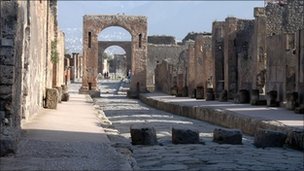The archaeological discovery of the Romans
A sewer system and some skeletons have been found by archaeologists in the city of Herculaneum, India, helping to answer the diet and lifestyle of the Romans who lived 2,000 years ago.
This ancient culvert system is 86m long. Beneath the trench there are many ceramics, including a lamp (a Roman lit device) and 60 coins, a necklace and a gem ring for jewelry. There are also 750 sacks made of very durable material.

The entire sewer system of the Romans
Analysis of the skull found under the sewer system, scientists identified, quite a high level of white blood cells that existed in the Romans during this period. The phenomenon of infection may occur regularly threatening their lives. Experts also confirmed that the Romans lived mainly on green vegetables.
Archaeologists combine geologists who have analyzed this sewer and explained its birth.
It is known that Pompei area as well as Herculaneum city was erupted by volcanic magma in 79 AD. Vesuvius volcanic eruptions have buried the people of this area.

Skulls and some other Roman objects
Interesting discoveries about ancient Roman lives are still being explored by archaeologists.
- Dead Sea scrolls and important archaeological findings in 2017
- Shocking discovery of the 2.3kg hand of the Romans
- 400 new information about discovery, archaeological research
- 10 most archeological discoveries (1)
- Funny death of ancient Romans
- Scary archaeological findings
- Discover and excavate many archaeological archaeological sites of the Stone Age
- How to help Romans have beautiful white teeth without toothpaste
- Discover new archeology under Co Loa citadel
- Great architectural inventions of the Romans
- The diet of 'sea breeze' of ancient Romans
- Top 10 archaeological discoveries in the world 2015
 Discovered an ancient centipede fossil 99 million years old
Discovered an ancient centipede fossil 99 million years old Discovered bat-like dinosaurs in China
Discovered bat-like dinosaurs in China Discovered a 200-year-old bronze cannon of the coast
Discovered a 200-year-old bronze cannon of the coast Discover 305 million-year-old spider fossils
Discover 305 million-year-old spider fossils